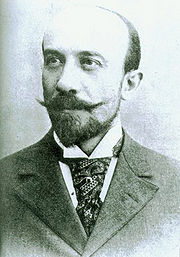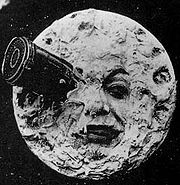Georges Méliès
| Georges Méliès | |
|---|---|
 |
|
| Born | Marie-Georges-Jean Méliès December 8, 1861 Paris, France |
| Died | January 21, 1938 (aged 76) Paris, France |
| Occupation | Filmmaker, Illusionist, Toymaker |
| Years active | 1896–1914 |
| Spouse | Jeanne d'Alcy (1926-1938) |
Georges Méliès (December 8, 1861 – January 21, 1938), full name Marie-Georges-Jean Méliès, was a French filmmaker famous for leading many technical and narrative developments in the earliest cinema. He was very innovative in the use of special effects. He accidentally discovered the stop trick, or substitution, in 1896, and was one of the first filmmakers to use multiple exposures, time-lapse photography, dissolves, and hand-painted color in his films. Because of his ability to seemingly manipulate and transform reality through cinematography, Méliès is sometimes referred to as the First "Cinemagician."[1]
Contents |
Biography
Méliès was born in Paris, where his family manufactured shoes. He had two older brothers, Henri and Gaston. Before making films, he was a stage magician at the Theatre Robert-Houdin.
In 1895, he became interested in film after seeing a demonstration of the Lumière brothers' camera. In 1897, he established a studio on a rooftop property in Montreuil. Actors performed in front of a painted set as inspired by the conventions of magic and musical theater. He directed 531 films between 1896 and 1914, ranging in length from one to forty minutes. In subject matter, these films are often similar to the magic theater shows that Méliès had been doing, containing "tricks" and impossible events, such as objects disappearing or changing size. These early special effects films were essentially devoid of plot. The special effects were used only to show what was possible, rather than enhance the overall film.
Melies early films were mostly composed of single in-camera effects, used for the entirety of the film. For example, after experimenting with multiple exposure, Melies created his film The One Man Band in which he played seven different characters simultaneously. [2]
His most famous film is A Trip to the Moon (Le voyage dans la Lune) made in 1902, which includes the celebrated scene in which a spaceship hits the eye of the man in the moon. Also famous is The Impossible Voyage (Le voyage à travers l'impossible) from 1904. Both of these films are about strange voyages, somewhat in the style of Jules Verne. These are considered to be some of the most important early science fiction films, although their approach is closer to fantasy. In addition, horror cinema can be traced back to Georges Méliès's Le Manoir du diable (1896).
In 1913 Georges Méliès' film company was forced into bankruptcy by the large French and American studios and his company was bought out of receivership by Pathé Frères. Méliès did not grasp the value of his films, and with some 500 films recorded on cellulose, the French Army seized most of this stock to be melted down into boot heels during World War I. Many of the other films were sold to be recycled into new film. As a result many of his films do not exist today.
After being driven out of business Méliès became a toy salesman at the Montparnasse station. In time, Méliès was rediscovered and honored for his work, eventually taking up stage performance. In 1932 the Cinema Society gave Méliès a home in Château d'Orly. Georges Méliès was also awarded the Légion d'honneur (Legion of honor), which was presented him by Louis Lumière.[3]
Méliès died in Paris and he was buried in the Père Lachaise Cemetery.[4]
His 1899 short film Cleopatra was believed to be a lost film until a copy was discovered in 2005 in Paris.
Filmography
Georges Méliès directed hundreds of films including the following. For a full filmography see Georges Méliès filmography.
- The Bewitched House / L'Auberge Ensorcelée (1896)
- Batteuse à vapeur (1896)
- Bébé et fillettes (1896)
- Le Bivouac (1896)
- Le chiffonnier (1896)
- Les Blanchisseuses (1896)
- Les chevaux de bois (1896)
- Bois de Boulogne (1896)
- Cortège de tzar au Bois de Boulogne (1896)
- Cortège de tzar allant à Versailles (1896)
- Couronnement de la rosière (1896)
- Déchargement de bateaux (1896)
- Dessinateur: Chamberlain (1896)
- Dessinateur express (1896)
- Dessinateur: Reine Victoria (1896)
- Dessinateur: Von Bismark (1896)
- Dix chapeaux en 60 secondes (1896)
- The Vanishing Lady / Escamotage d'une dame chez Robert-Houdin (1896)
- The House of the Devil / Le Manoir du Diable (1896)
- Boulevard des Italiens (1896)
- The Four Troublesome Heads / Un Homme de Têtes (1898)
- An Up-to-Date Conjuror / Illusioniste fin de Siècle (1899)
- The Conjuror (1899)
- Cinderella / Cendrillon (1899)
- The Dreyfus Affair / L'affaire Dreyfus (1899)
- Jeanne d'Arc (1899)
- Fat and Lean Wrestling Match / Nouvelles Luttes Extravagantes (1900)
- One Man Band / L'homme-Orchestre (1900)
- The Two Blind Men / Les Deux Aveugles (1900)
- Bluebeard / Barbe-Bleue (1901)
- A Trip to the Moon / Le Voyage dans la Lune (1902)
- The Man With The Rubber Head / L'homme à la tête de Caoutchouc (1902)
- Gulliver's Travels / Le Voyage de Gulliver à Lilliput et chez les Géants (1902)
- Extraordinary Illusions / Illusions Funambulesques (1903)
- The Enchanted Well / Le Puits Fantastique (1903)
- The Apparation / Le Revenant (1903)
- The Music Lover / Le Mélomane (1903)
- The Infernal Boiling Pot / Le Chaudron Infernal (1903)
- The Infernal Cakewalk / Le Cake-walk Infernal (1903)
- The Inn Where No Man Rests / L'Auberge du Bon Repos (1903)
- The Mystical Flame / La Flamme Merveilleuse (1903)
- Kingdom of the Fairies / Le Royaume des Fées (1903)
- The Monster / Le Monstre (1903)
- The Magic Lantern / La Lanterne Magicue (1903)
- The Ballet Master's Dream / La Rêve du Maître de Ballet (1903)
- The Damnation of Faust / La Damnation de Faust (1903)
- The Living Playing Cards / Les Cartes Vivantes (1904)
- Imperceptible Transmutations / Le Thaumaturge Chinois (1904)
- The Terrible Turkish Executioner / Le Bourreau Turc (1904)
- Untameable Whiskers / Le Roi du Maquillage (1904)
- The Impossible Voyage / Le Voyage à Travers l'Impossible (1904)
- The Scheming Gambler's Paradise / Le Tripot Clandestin (1905)
- Hilarious Posters / Les affiches en Guette (1905)
- Palace of the Arabian Knights / Le Palais des Mille et une Nuits (1905)
- Paris to Monte Carlo / Le raid Paris-Monte Carlo en Deux Heures (1905)
- The Merry Frolics of Satan / Les 400 Farces du Diable (1906)
- The Mysterious Retort / L'Alchimiste Parafaragamus ou La Cornue Infernale (1906)
- 20,000 Leagues Under the Sea / 20,000 Lieues Sous les Mers (1907)
- The Eclipse: Courtship of the Sun and Moon / L'éclipse du soleil en pleine lune (1907)
- Dream of an Opium Eater / Le Rêve d'un Fumeur d'opium (1907)
- The Devilish Tenant / Le Locataire Diabolique (1909)
- The Doctor's Secret / Hydrothérapie Fantastique (1910)
- Conquest of the Pole / La Conquète du Pole (1912)
- Baron Munchausen's Dream / Les hallucinations du Baron de Münchausen (1911)
- The Ranchman's Debt of Honor (1911 - USA)
- The Knight of the Snows / Le Chevalier des Neiges (1912)
- Cinderella or The Glass Slipper / Cendrillon ou La Pantoufle Mystérieuse (1912)
- The Ghost of Sulpher Mountain (1912 -USA)
- The Prisoner's Story (1912 - USA)
- Le Voyage de la Famille Bourrichon (1913)
Videorecordings
- Films of George Méliès
- The Great Train Robbery and Other Primary Works
- Marvelous Méliès
- Méliès Le Cinémagicien
- Mes Mémoires
- Pioneers of the French Cinema, Volume One
- Le Grand Méliès (1952) - The life of Georges Méliès is told in this biodrama, directed by Georges Franju. André Méliès plays the part of his own father.
Popular culture
The work of Georges Méliès has been referenced a number of times in film, television and fiction, including:
- The music video for The Smashing Pumpkins' song "Tonight, Tonight" was largely shot in the style of Méliès' best-known films, particularly "A Trip to the Moon." The video also features a paddle wheel steamship named "S.S. Méliès."
- In the HBO miniseries From The Earth to the Moon, Méliès was played by Tchéky Karyo.
- Canadian filmmaker Guy Maddin and video artist Timothy Hutchings are both contemporary culture workers who make motion pictures inspired by Méliès.
- Queen's 1995 video "Heaven for Everyone" uses clips from Le Voyage dans la Lune
- The 2007 children's novel The Invention of Hugo Cabret by Brian Selznick details the story of a young girl, Isabelle, and Hugo, the son of a horologist, who discover Georges Méliès' secret in 1931 Paris. This book won the Caldecott Medal in 2008.
- Threadless T-shirt designs printed a shirt entitled Le Voyage Dans La Lune which depicts a scene from the famous film of the same name.
- In series 2 and 3 of The Mighty Boosh, an incidental character called 'The Moon' appears, complete with a face covered in shaving foam, bearing a strong resemblance to Méliès' moon in Le Voyage Dans La Lune.
- In the episode of Futurama titled "The Series Has Landed" an amusement park mascot with a moon for a face tells Bender "I'll have to confiscate your alcohol" resulting in Bender planting a beer bottle in his right eye, leaving him looking like Méliès' moon with the spacecraft in its eye.
See also
- Gaston Méliès
References
- ↑ Méliès, le cinémagicien, documentary.
- ↑ Fry & Fourzon, The Saga of Special Effects, pp. 8
- ↑ Elizabeth Ezra. Georges Méliès: the birth of the auteur (Manchester: Manchester University Press, 2000): 20.
- ↑ "Georges Melies. French Motion Picture Producer a Pioneer in Industry.". New York Times. January 23, 1938. http://select.nytimes.com/gst/abstract.html?res=FA0C1EFC355A157A93C1AB178AD85F4C8385F9. Retrieved 2008-05-09.
External links
- Georges Méliès at Find a Grave
- Georges Méliès at Who's Who of Victorian Cinema
- Georges Méliès at the Internet Movie Database
- Museo Méliès, English and Spanish (Pequeña Coleccion Privada)
- Index des Films avec Georges Méliès
- Cinémathèque Méliès (Les Amis de Georges Méliès)
- Georges Méliès - daily in-depth reviews of individual Méliès films
- [1]
|
|||||||||||
